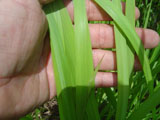Sign up for the iWire to get breaking news, event info and the species spotlight.
Go Back | Printer Friendly Fact Sheet
NOTE:
Imperata cylindrica
Cogongrass
Synonym(s): Imperata arundinacea, Lagurus cylindricus
Family: Poaceae (Grass Family)
Duration and Habit: Perennial Grass/Grasslike

Photographer: Charles T. Bryson
Source: USDA Agricultural Research Service, Bugwood.org
Description
Cogon grass is a perennial, rhizomatous grass that grows from 2 to over 4 feet in height. The leaves are about an inch wide, have a prominent white midrib, and end in a sharp point. Leaf margins are finely toothed and are embedded with silica crystals. The upper surface of the leaf blade is hairy near the base; the undersurface is usually hairless. The flowers are arranged in a silvery, cylindrical, branching structure, or panicle, about 3-11 inches long and 1 1/2 inches wide.
Native Lookalikes: Currently no information available here yet, or there are no native Texas species that could be confused with Cogongrass.
Ecological Threat: Cogon grass can invade and overtake disturbed ecosystems, forming a dense mat of thatch and leaves that makes it nearly impossible for other plants to coexist. Large infestations of cogon grass can alter the normal fire regime of a fire-driven ecosystem by causing more frequent and intense fires that injure or destroy native plants. Cogon grass displaces a large variety of native plant species used by native animals (e.g., insects, mammals, and birds) as forage, host plants and shelter. Some ground-nesting species have also been known to be displaced due to the dense cover that cogon grass creates.
Biology & Spread: Cogon grass reproduces both vegetatively and from seed. A single plant can produce several thousand very small seeds that may be carried great distances by the wind. Vegetative spread of cogon grass is aided by its tough and massive rhizomes that may remain dormant for extended periods of time before sprouting. Rhizomes of cogon grass may be transported to new sites in contaminated fill dirt or by equipment used in infested areas.
History: Introduced from Southeast Asia into Florida and southern Louisiana, southern Alabama, and southern Georgia in the early 1900s. Initially for soil stabilization. Expectations for improved forage unrealized. A Federal listed noxious weed.
U.S. Habitat: Grows in full sunlight to partial shade, and, thus, can invade a range of sites. Often in circular infestations with rapidly growing and branching rhizomes forming a dense mat to exclude most other vegetation. Aggressively invades right-of-ways, new forest plantations, open forests, old fields, and pastures. Absent in areas with frequent tillage. Colonizes by rhizomes and spreads by wind-dispersed seeds and promoted by burning. Highly flammable and a severe fire hazard, burning extremely hot especially in winter.
Distribution
U.S. Nativity: Introduced to U.S.
Native Origin: Old World trop. & temp regions (Germplasm Resources Information Network); NatureServe Explorer
U.S. Present: AL, FL, LA, MS, OR, SC
Distribution in Texas: Cogon grass is distributed throughout the south and southeastern United States as far west as eastern Texas. There have been reports of cogon grass surviving as far north as Virginia, West Virginia and Maryland.
If you believe you have found cogongrass, please report this species.
Mapping
Invaders of Texas Map: Imperata cylindrica
EDDMapS: Imperata cylindrica
USDA Plants Texas County Map: Imperata cylindrica
Invaders of Texas Observations
List All Observations of Imperata cylindrica reported by Citizen Scientists
Native Alternatives
A number of native plants should be considered for replanting areas that were infested with cogon grass. Each scenario will require a different approach to return an area previously infested with cogon grass to a healthy ecosystem. Specialists in cogon grass management should be contacted for assistance.
Management
An integrated approach to cogon grass management, including chemical, mechanical and cultural methods, is necessary to achieve successful, long lasting control. Effective management of cogon grass has been achieved by the following combined mechanical-chemical protocol. First, the infested area is mowed in late spring to remove last year?s growth and the accumulated thatch layer. About six to eight weeks later, when about eighty percent of the cogon grass has resprouted to a height of 6-12 inches, the site needs to be disced as deeply as possible. [Discing may not be possible in all areas, due to the sensitive nature of some ecosystems]. When adequate regrowth of the cogon grass has occurred, systemic herbicides (chemicals are carried through the plant tissues to the roots) are applied.
Text References
Gaffney, J. F. 1996. Ecophysiological and technological factors influencing the management of cogon grass (Imperata cylindrica). Dissertation. Agronomy Department, University of Florida, Gainesville, Florida.
Johnson, E. R. R. L. and D. G. Shilling. 1998. Hernando County Final Report. Agronomy Department, University of Florida, Gainesville, Florida.
Lippincott, C. L. 1997. Ecological consequences of Imperata cylindrica (cogon grass): Invasion in Florida Sandhill. Dissertation. Botany Department, University of Florida, Gainesville, Florida.
Online Resources
APWG WeedUS Database
Miller, J.H. 2003. Nonnative invasive plants of southern forests: a field guide for identification and control. Gen. Tech. Rep. SRS-62. Asheville, NC: U.S. Department of Agriculture, Forest Service, Southern Research Station. 93 pp (USDA SRS).
Cogongrass: Invading Texas Forest
Search Online
Google Search: Imperata cylindrica
Google Images: Imperata cylindrica
NatureServe Explorer: Imperata cylindrica
USDA Plants: Imperata cylindrica
Invasive Plant Atlas of the United States: Imperata cylindrica
Bugwood Network Images: Imperata cylindrica









